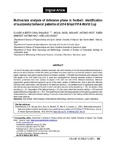Mostrar o rexistro simple do ítem
Multivariate Analysis of Defensive Phase in Football: Identification of Successful Behavior Patterns of 2014 Brazil FIFA World Cup
| dc.contributor.author | Casal Sanjurjo, Claudio Alberto | |
| dc.contributor.author | Andujar Casais, Miguel Ángel | |
| dc.contributor.author | Ardá Suárez, Antonio | |
| dc.contributor.author | Maneiro, Rubén | |
| dc.contributor.author | Rial, Antonio | |
| dc.contributor.author | Losada, J.L. | |
| dc.date.accessioned | 2021-09-30T18:03:14Z | |
| dc.date.available | 2021-09-30T18:03:14Z | |
| dc.date.issued | 2021-07-01 | |
| dc.identifier.citation | Journal of Human Sport and Exercise. 2021, 16(3): 503-516. https://doi.org/10.14198/jhse.2021.163.03 | es_ES |
| dc.identifier.issn | 1988-5202 | |
| dc.identifier.uri | http://hdl.handle.net/2183/28542 | |
| dc.description.abstract | [Abstract] The aim of this study was to identify variables associated with direct recovery of the ball during defensive transitions in elite soccer and to propose a model with certain guarantees of success based on a multivariate analysis in which binary logistic regression was used to explore interaction between variables. 1,722 defensive transitions were analysed in the final stages of the FIFA World Cup 2014 in Brazil and investigated the following variables: duration of defensive transition; possession loss zone; position of players at the start and end of the defensive transitions, defensive organization, general defensive approach, period of the match, position of defence line, zone in which the offensive transition ends, match status, and outcome of the defensive transition. The variables found to significantly associated with ball recovery were the area of the pitch in which the ball is lost prior to the transition (p < .05), the duration of the transition (p < .01), the position of the defence lines (p < .01), the zone in which the transition ends (p < .001) and end spatial interaction configuration (p < .001). The model that provided the best guarantees of recovering possession was characterized by a defensive transition lasting 15 seconds or less that ends in the holding midfield with the attacking team under pressure. | es_ES |
| dc.description.sponsorship | Generalitat Valenciana; GV2017/044 | es_ES |
| dc.description.sponsorship | Universidad Católica de Valencia; UCV2017/230-002 | es_ES |
| dc.language.iso | eng | es_ES |
| dc.publisher | Universidad de Alicante. Área de Educación Física y Deporte | es_ES |
| dc.relation.uri | https://doi.org/10.14198/jhse.2021.163.03 | es_ES |
| dc.rights | Atribución-NoComercial-SinDerivadas 4.0 Internacional | es_ES |
| dc.rights.uri | http://creativecommons.org/licenses/by-nc-nd/4.0/ | * |
| dc.subject | Elite football | es_ES |
| dc.subject | Match analysis | es_ES |
| dc.subject | Observational methodology | es_ES |
| dc.subject | Defensive transitions | es_ES |
| dc.subject | Logistic regression | es_ES |
| dc.subject | Fútbol de élite | es_ES |
| dc.subject | Análisis de partido | es_ES |
| dc.subject | Metodología observacional | es_ES |
| dc.subject | Transiciones defensivas | es_ES |
| dc.subject | Regresión logística | es_ES |
| dc.subject | Fútbol de elite | es_ES |
| dc.subject | Análise de partido | es_ES |
| dc.subject | Metodoloxía observacional | es_ES |
| dc.subject | Transicións defensivas | es_ES |
| dc.subject | Regresión loxística | es_ES |
| dc.title | Multivariate Analysis of Defensive Phase in Football: Identification of Successful Behavior Patterns of 2014 Brazil FIFA World Cup | es_ES |
| dc.type | info:eu-repo/semantics/article | es_ES |
| dc.rights.access | info:eu-repo/semantics/openAccess | es_ES |
| UDC.journalTitle | Journal of Human Sport and Exercise | es_ES |
| UDC.volume | 16 | es_ES |
| UDC.issue | 3 | es_ES |
| UDC.startPage | 503 | es_ES |
| UDC.endPage | 516 | es_ES |
Ficheiros no ítem
Este ítem aparece na(s) seguinte(s) colección(s)
-
GI-PHG - Artigos [111]






